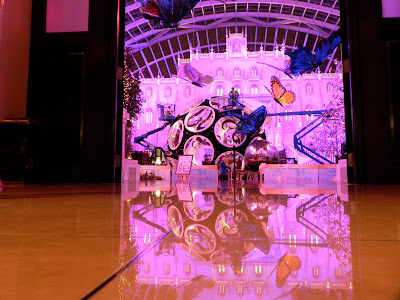I was introduced to Kew's plans last year to create a UK native seed hub at their country estate, Wakehurst Place. Having succesfully secured over 10% of the worlds most vunerable plant species within their Millenium Seed Bank and safely stored in underground fridges, their focus is also looking toward our native wildflowers and meadow plants here in the UK.
Their whole thought process is deeply rooted in conservation. Currently there are some fairly generic wildflower seed mixes available to buy containing seeds from other areas of Europe, so their focus is on our native species.
Kew have decided not only to secure the native seeds within the banks but also to lead the production of these delicate and rare natives, which in turn will educate the larger producers and filter back into our gardens! It's Genius!
The site is directly opposite the seed bank and over a period of years has been restored back to a more natural meadow, a flock of southdown sheep graze this on rotation and an apairy of 6 hives help to pollinate the flowers. Within this are 24 production seed beds, on a monumental scale, which are cared for meticulously by a team of Kew staff.
To link all of this together I have designed a series of sculptural interpretation that creates a trail through the meadow and beds. The site was opened last week and with this persistent wet weather it has been a serious labour of love for all concerned, my boots are nearly dry!
Within these beautiful oak frame buildings are storyboards and explanations behind the work.
The opening event saw a turn out of around 200+. Here is Dawn Austwick from the
Esmee Fairbairn Foundation and Keith Datchler from the
Grassland Trust both cutting the willow chain with shiny new secateurs under the main entrance feature, which is a 4.5 metre tall sculpture of Red Campion seed heads dispersing their, seed!
Note the solitary white seed to the right of the picture which tells another story of germination and survival rates.
The Campion heads were woven in Whissender willows around a steel frame. The seeds themselves are in boiled Triandra and stripped white.
The view back towards The Millenium Seed Bank.
Next on the journey is a Giant Harebell sculpture, woven in brittany blue on mild steel arching over the gate which leads into the production seed beds.
Directly opposite and leading towards the apairy is one of my favourites, the Wild Carrot flower head. This involved cleaving an oak log, shaping laths with a drawknife, steam bending and also pickling the oak, not to mention the usual steelworks and weaving!
I will be blogging some behind the scenes images and process later.
Wild Carrot flower head - stripped white willow, pickled oak with mild steel.
Taking a wee stroll in between the newly layed hawthorn hedgerow leads you towards the Oxeye Daisy sculpture, which marks the top of the seed beds. The daisy stands 3.5 meters tall and leans over the gateway. It's woven in stripped white willows, flanders red and brown black maul.
Oxeye daisy with Husk sculptures in view.
So right at the very top of the beds we have created a resting place, a picnic stop to enjoy the seed beds in all their glory and the wonderful vista as the landscape drops away.
The sculptures are based on Husk forms. Each component is around 2.8 metres in height and there is a larger 5 metre diameter pod made up of 6 husks and then as if scattered by the wind there are three smaller pods dispersed along the top of the beds.
The husks are woven in a very dark boiled willow around a mild steel frame and create amazing shadows.
Completing the journey will take you back to the oak frame building next to which stands the Pasque flower and seed head woven with flanders, triandra and white willow.
Nestled away in the apex of the oak frame is my first willow writing!
and to the left of this is another oak framed building with woven seed forms on oak laths.
As with all these big projects they rely on certain characters to achieve the deadlines and some of the more challenging logistics. So this seems like a great opportunity to say 'Thank You' to the people involved. Firstly I would like to mention Joanna Wenham and Iain Parkinson from Kew who had the vision in the first instance, they also co-ordinated the whole seed hub project and supported me onsite.
My respect also goes out to
Andy Artfabs and Pete Lorimer who produced the larger steel work and translated the maquette's beautifully. Pete Zee and Jo my humble weaverbirds, and finally Peter wood, Nick Castledine and Rory Watson, all of which played a significant role in the production and installation of these incredible pieces.



















































